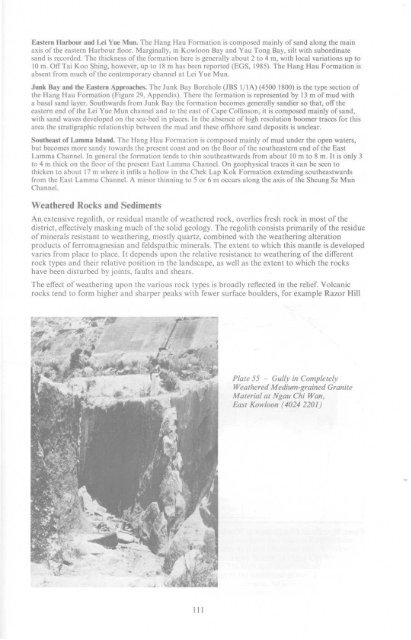Superficial Geology
Superficial Geology
Superficial Geology
You also want an ePaper? Increase the reach of your titles
YUMPU automatically turns print PDFs into web optimized ePapers that Google loves.
Eastern Harbour and Lei Yue Mun. The Hang Hau Formation is composed mainly of sand along the main<br />
axis of the eastern Harbour floor. Marginally, in Kowloon Bay and Yau Tong Bay, silt with subordinate<br />
sand is recorded. The thickness of the formation here is generally about 2 to 4 m, with local variations up to<br />
10 m. OffTai Koo Shing, however, up to 18m has been reported (EGS, 1985). The Hang Hau Formation is<br />
absent from much of the contemporary channel at Lei Yue Mun.<br />
Junk Bay and the Eastern Approaches. The Junk Bay Borehole (IBS 1/1 A) (4500 1800) is the type section of<br />
the Hang Hau Formation (Figure 29, Appendix). There the formation is represented by 13 m of mud with<br />
a basal sand layer. Southwards from Junk Bay the formation becomes generally sandier so that, off the<br />
eastern end of the Lei Yue Mun channel and to the east of Cape Collinson, it is composed mainly of sand,<br />
with sand waves developed on the sea-bed in places. In the absence of high resolution boomer traces for this<br />
area the stratigraphic relationship between the mud and these offshore sand deposits is unclear.<br />
Southeast of Lamma Island. The Hang Hau Formation is composed mainly of mud under the open waters,<br />
but becomes more sandy towards the present coast and on the floor of the southeastern end of the East<br />
Lamma Channel. In general the formation tends to thin southeastwards from about 10 m to 8 m. It is only 3<br />
to 4 m thick on the floor of the present East Lamma Channel. On geophysical traces it can be seen to<br />
thicken to about 17 m where it infils a hollow in the Chek Lap Kok Formation extending southeastwards<br />
from the East Lamma Channel. A minor thinning to 5 or 6 m occurs along the axis of the Sheung Sz Mun<br />
Channel.<br />
Weathered Rocks and Sediments<br />
An extensive regolith, or residual mantle of weathered rock, overlies fresh rock in most of the<br />
district, effectively masking much of the solid geology. The regolith consists primarily of the residue<br />
of minerals resistant to weathering, mostly quartz, combined with the weathering alteration<br />
products of ferromagnesian and feldspathic minerals. The extent to which this mantle is developed<br />
varies from place to place. It depends upon the relative resistance to weathering of the different<br />
rock types and their relative position in the landscape, as well as the extent to which the rocks<br />
have been disturbed by joints, faults and shears.<br />
The effect of weathering upon the various rock types is broadly reflected in the relief. Volcanic<br />
rocks tend to form higher and sharper peaks with fewer surface boulders, for example Razor Hill<br />
Plate 55 - Gully in Completely<br />
Weathered Medium-grained Granite<br />
Material at Ngau Chi Wan,<br />
East Kowloon (4024 2201)<br />
111

















